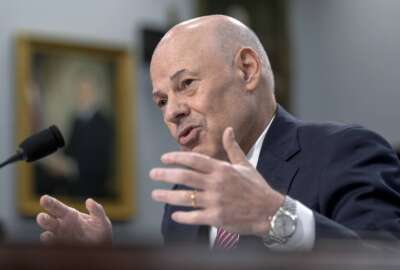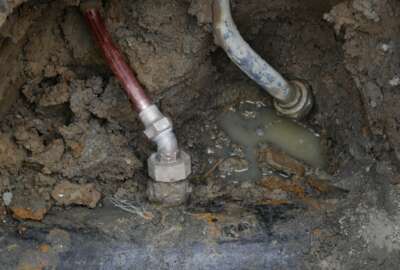This Labor Department team broke up a ring using child labor in slaughterhouses
The Labor Department team is now a finalist for the Service to America Medal Awards for its work's broader effects on child labor enforcement.
Imagine using young teenagers in a slaughterhouse to clean dangerous machinery. That’s what a sanitation company was doing until discovered and stopped by a team from the Labor Department. That group is now a finalist in this year’s Service to America Medals program. The Wage and Hour Division Regional Enforcement Coordinator Shannon Rebolledo, and Planning and Reporting Coordinator Justin Uphold shared details with the Federal Drive with Tom Temin.
Interview transcript:
Tom Temin
Miss Rebolledo, tell us what happened here. What was going on? This was not the slaughterhouse itself, but a contractor to it that was doing this.Shannon Rebolledo
That’s correct. It was a sanitation company that specialized in sanitizing slaughterhouses across the country for a number of different processors.Tom Temin
Right. So this was work that would be done, sounds like, overnight.Shannon Rebolledo
Correct. This shift started at 10 o’clock at night, and went through the evening until the morning.Tom Temin
It sounds like it could be dangerous work. Tell us the nature of the work. And then who you found was actually doing it?Justin Uphold
Well, we were able to identify a number of different minors ages from 13 to 17 that were employed overnight in dangerous jobs there.Tom Temin
I mean, what were they doing that was so dangerous?Shannon Rebolledo
The minors that we found were cleaning saws, bone saws, head splitters, they were cleaning the slaughterhouse floor where thousands of animals are moved through production daily. And they were doing this at night using dangerous chemicals, hot water, and doing things that they had no business doing.Tom Temin
Right. So this sounds like it was violating several statutes: One, child labor if they were as young as 13, but maybe give us a sense of what they were doing wrong, what they should not have been doing, besides working itself.Shannon Rebolledo
There are various child labor provisions requiring that number one, you be at least 14 years of age to work and we found three minors that weren’t even 14 years old. And in addition to that, there are hours and occupational restrictions for 14 and 15 year olds. Again, we found them working in occupations that were hazardous on the slaughterhouse floor, we found them working at times that they are not legally able to work. And then in addition to that, we found hazardous occupation violations which are identified for anyone under the age of 18. And that includes cleaning those machines that are so dangerous, that head splitter, that bone saw.Tom Temin
Sure I won’t even ask what a head splitter is. But it doesn’t sound like a very fun machine. And how did this come to the Labor Department’s attention? How did it come to the the Wage and Hour Division’s knowledge in the first place?Shannon Rebolledo
We received credible information that there were minors in Grand Island, Nebraska, that were coming to school tired, that they were coming to school injured from chemical burns, and it was well known within the community that minors were working the overnight shift at the JBS plant and employed by PSSI, which is Packer Sanitation.Tom Temin
So what does the department do then, when it discovers this information?Justin Uphold
So when it comes to having a large and diverse approach to enforcement, we like to plan ahead of time. And when we get information, sometimes we have to go out on a one-on-one basis and determine that information. And sometimes in the past, we’ve gone and just initiated the case. But here we decided to establish more information upfront and really plan our enforcement strategy using data and analysis techniques on where some of the minors could be located to conduct the strikeforce at multiple locations at the same time, in tandem.Tom Temin
And just out of curiosity, does the Labor Department have subpoena power or the ability to get this documentation from the various companies that the sanitation company was serving so that you could see the records and do that data gathering?Justin Uphold
That’s correct. We did use subpoenas and we worked with our regional solicitor to to get search warrants to conduct the 10 search warrants across all locations. And we really couldn’t have done that without the support of the solicitor’s office.Tom Temin
What is the nature of the children that were actually working? Were they immigrants or I mean, were they impoverished? Tell us more about about them.Shannon Rebolledo
The kids that we found, Tom, they could have been my kids, they could have been your kids; they were just kids in this country. And you looked at their faces, and they were tired. They were scared because they’re talking to federal investigators. But they were just normal kids and they were working, they wanted to go to school. They just wanted to have a good life.Tom Temin
We’re speaking with Shannon Rebolledo, she is regional enforcement coordinator, and with Justin Uphold, planning and reporting coordinator in the Wage and Hour Division of the Labor Department. It strikes me Child Protective Services, other agencies outside of Labor, even at the state and local level, were they involved also here?Shannon Rebolledo
What we found is that they had been involved, many different agencies that had been involved in different capacities over an extended period of time. Like I said, this seemed to be a known issue within the community. But each agency was taking over their own piece of enforcement. And it would end with whatever that one isolated incident was. And one of the things that was different about our enforcement action, as Justin mentioned, is that we didn’t just come in, find what we already knew was happening at this one place. We really wanted to get an idea, is this something that is isolated? And at this one location, at this one plant? Or this one manager? Or is this a systemic problem, and what we found was it was indeed a systemic problem across the country.Tom Temin
And this was one contractor then that has multiple locations, in other words, the sanitation services.Shannon Rebolledo
That’s correct. And we ended up looking at, I believe, about 55 locations across the country, different states, different processors. And what we found was, regardless of the state, regardless of the processor, they had the same problem.Tom Temin
When you went to Packer Sanitation Services, and did your investigation did at some point you say, what the heck are you people doing here using child labor? Somebody there had to know this was not, let’s say, compliant?Justin Uphold
Well, when you opened the interview, you asked for them to imagine that this was happening. And it is really hard to imagine that this could happen. And when you see it, and you are hearing about it from the investigators in the field, as we were having discussions with the company’s leadership and strategizing with our leadership, it really was apparent that this was a systemic issue, and it really was unimaginable. And so it was a new thing that we had to develop a strategy for to show and prove to the employer also that this was going on, because of the large scale and multiple work sites. The employer’s representatives don’t may not have experience with every single worksite, or know who’s working in every location. So it was as much about proving to them that these issues were going on as well.Tom Temin
Yeah, it’s a wonder some of the packers themselves when they hired Packers Sanitation didn’t say, how come you’re bringing 13 year olds into my factory?Shannon Rebolledo
I think that I said just that: How is it that these kids walked in every night to go and work this shift, this dangerous shift at night, and no one said anything? Not the security guard that they passed by, not the other workers that worked for the processor, not anyone else who worked for the sanitation company, because these kids were little. We went out and we conducted surveillance prior to initiating our case. And as we watched them walk in, Nancy Alcantara, our director of enforcement was with me. And we just looked at each other and we said, ‘wow, these are kids, they are little.’Tom Temin
Alright, so you were eventually able to get a large settlement, $1.5 million from Packers Sanitation Services, but your SAMMIES Award citation says that this case altered in some fundamental way the way the Labor Department goes about child labor enforcement generally. Tell us more about that.Shannon Rebolledo
Well, you’re right, the civil money penalty that was issued as a result of this case was one of the largest in the history of our agency; it was $1.5 million. But aside from that, we really brought attention to a problem that most people didn’t realize was so prevalent. Most people think child labor, they picture that black and white picture of a kid in a coal mine 100 years ago, and we realized, this isn’t a 100 year old problem, this is a now problem. And so as a result, we focused our activities. As an agency, we conducted nearly 1000 child labor investigations the following year. There was also a strategic enforcement initiative that was created by our agency to focus on exploitative child labor. There was an interagency task force that was created, that engages different agencies, each of us having our own little piece of the puzzle or a piece of the pie when it comes to child labor enforcement. So instead of Wage and Hour just handling the child labor enforcement section. Now we have a taskforce that we’re engaging the Department of State and the Department of Justice, Health and Human Services, we also conducted over 1700 outreach events, targeting child labor so that we could raise awareness in the communities.Justin Uphold
On the outreach event topic, we were able to, with this work, prove to our stakeholders that this is really what we are willing to do when it comes to a bad actor in the enforcement environment, that we are ready to go to more in depth and higher level investigative practices and techniques to be able to capture these violations. And I think it’s shown to stakeholders publicly that we are willing to do the work, and we are listening. And so we’ve really grown in relationship with a lot of stakeholders in this field.Tom Temin
And do you get the sense, as a final question, that maybe because of what happened with Packers Sanitation Services, maybe some of the other sanitary companies, and maybe some of the packers themselves, may be voluntarily cleaning up on their own before you come around.Justin Uphold
Absoutely. We’ve seen changes happening reported in the media, and we’re sure we’re going to continue to see changes. But something that this award does and this nomination does is it shows if our work matters here at this department, that the people we’re helping matter and we’re helping them be able to understand their rights and know that they are worth being safe in their work environment, and they should not be subjected to the conditions, as a child, to work in such a dangerous and hazardous environment.
Copyright © 2024 Federal News Network. All rights reserved. This website is not intended for users located within the European Economic Area.
Tom Temin is host of the Federal Drive and has been providing insight on federal technology and management issues for more than 30 years.
Follow @tteminWFED






